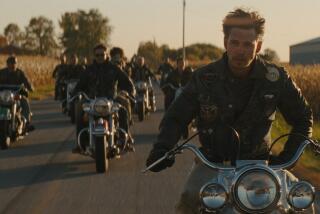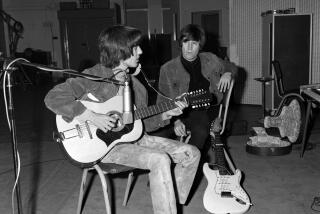2-Wheel Treasures : Van Nuys machinist restores antique motorcycles to museum-grade perfection.
- Share via
One of the prizes in Mike Parti’s jewel-like collection of antique motorcycles was a rusted skele ton when he pulled it out of a Northern California creek a dozen years ago.
The motorcycle is a rare 1913 Yale, brought back to as-new condition in an extensive, five-year restoration by Parti. It now sits in Parti’s tiny Van Nuys garage, one of 23 bikes--along with a 1903 Orient, a 1906 Reading Standard, a 1906 Crouch, a 1907 Indian, a 1911 Excelsior and a 1916 Harley-Davidson--that he has restored from dereliction to museum-grade perfection.
Replacing missing or hopelessly damaged parts on a 1913 motorcycle is a challenge made easier because Parti happens to be a machinist whose business is making parts.
“It’s usually easier to make a new part for an 80-year-old machine than it is to restore an old one,” says Parti, 57, a husky, blunt-speaking man who wears thick glasses and walks with a limp, a reminder of the hazards of his former motorcycle racing career.
“For the Yale, I had to make half of the front forks, the exhaust system, the pedal crank arms and the primary chain case,” he says.
The pieces he is describing are components of a delicate-looking machine with the large, thin tires and long handlebars of the era, a bike Parti considers significant in early American motorcycle history.
“In 1903, a Yale made the first recorded cross-country motorcycle trip,” Parti says. “By 1913, the year of my bike, there were 300 American motorcycle manufacturers.”
Today, only one, Harley-Davidson, survives. The serial number of Parti’s Yale indicates that it was the 22,000th motorcycle produced by Yale. Today, he believes that between 20 and 30 Yales exist. His flawlessly restored 1903 Orient is one of perhaps five surviving Orients.
His 1911 Excelsior, one of a handful of Excelsiors, carries the distinction of being the first motorcycle clocked at 100 m.p.h.
“That was fast in those days,” says Parti, himself a three-time American national motorcycle side-car racing champion.
“There wasn’t anything else that fast then. No car could do that. No plane could go that fast. Nothing could, except maybe a train, on a demonstration speed run. Motorcycle racers were really the daredevils of the era.”
Parti, whose family moved to Southern California from Indiana in 1945, was trained as a machinist, and took up racing motorcycles because he could not afford to race cars. He found his niche in the rather arcane arena of motorcycle sidecar racing, in which he was the American Motorcycle Assn. national champion from 1965-67.
After breaking both arms in a crash in 1975, Parti took to collecting and restoring old bikes full time. He still rides, but only on the street. And because of their rarity, Parti does not ride his antique bikes.
“I fire them up when I first put them back together, and some of them I’ve ridden once,” Parti says, “but that’s it. I restore them as examples of what those bikes were, exactly the way they were, so future generations can see what they were like.”
Parti’s perfectionism in the shop extends to exactly duplicating the material and machinery used when the motorcycles were new. That means manufacturing nuts and bolts to the correct, original thread patterns.
“A good restorer is really a good counterfeiter,” Parti says. “The really challenging thing is to make everything exactly right. When you do, you end up with parts that are stronger and better than they’d be if you restored the original parts.”
Parti’s skill and resourcefulness have brought him a select, far-flung clientele.
One of his customers is “Tonight Show” host and comic Jay Leno, a dedicated and respected collector of vintage and antique motorcycles. Parti is restoring a 1911 Pope for Leno.
“He’s probably the last of the seat-of-the-pants kind of craftsmen,” says Leno, himself an accomplished mechanic. “There are people who sit down with computers and take measurements. And there are people like Mike who just eyeball it. They look at a part and say, ‘That’s one ten-thousandths of an inch off.’ And you measure it and say, ‘Gee, it’s one ten-thousandths of an inch off.’ ”
Chris Scott, proprietor of Supertwins, a Studio City shop specializing in restoration and repair of vintage (‘50s, ‘60s and ‘70s) British bikes, sees Parti as an example of a vanishing breed of machinists.
“Mike has a wealth of knowledge that’s beyond most people’s ability to imagine,” Scott says. “You can take him a part, and he’ll tell you what it is, what it’s supposed to look like. And he can make it. And he’ll charge you a fair price. Guys like him are living legends in the business.”
Parti’s antique motorcycles share display space in his garage with period motorcycle pictures, brochures and advertisements that show the machines in their historical and cultural context.
“Before the Model T Ford came out,” Parti says, “motorcycles were a really viable, attractive means of transportation. But when Henry brought out his car for only $400,” it was so close in price to motorcycles that the appeal of the two-wheeled machines suddenly dimmed.
Still, a rich legacy of pre-World War I machines exists, so rich that Parti limits his customers to those with pre-World War I bikes. Exceptions are made for Indians, Triumphs or Vincents, three marques to which Parti, for his own reasons, is partial. A typical antique motorcycle restoration costs about $15,000 and takes about a year.
He has another selective criteria for custom work: His customers must know how to find him. He does not advertise, and his phone is unlisted.
“The people who have machines that it makes sense for me to work on always manage to find me, one way or the other,” Parti says.
Although vintage and antique motorcycles have been subject to wild surges in price trends through the 1980s and early 1990s, Parti refrains from putting a dollar value on his bikes.
“I’m not a rich guy,” Parti says. “I pick things up, bikes in very poor condition, in the hundreds of dollars range, in pieces and make stuff out of them.”
“These bikes are my personal treasure,” he says. “I don’t ride them because I want them intact when I’m gone.”






